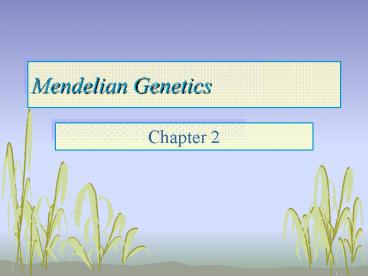Mendelian Genetics - PowerPoint PPT Presentation
1 / 38
Title:
Mendelian Genetics
Description:
Mendelian Genetics Chapter 2 Phenotype ... The Chi-Square Test Statistical Analysis Data from genetics is quantitative Use statistics to show deviation of observed ... – PowerPoint PPT presentation
Number of Views:47
Avg rating:3.0/5.0
Title: Mendelian Genetics
1
Mendelian Genetics
- Chapter 2
2
- Phenotype and Genotype
3
Genotype and Phenotype
- Genotype genetic constitution of an organism
- Phenotype observable characteristic
- Genotype and environment
- Contribution of environment varies between genes
- Can be controlled by many genes
- Random developmental events
4
- Mendels Experimental Design
5
Mendelian Genetics
- Modern genetics began with Gregor Mendels
quantitative genetic experiments - Austrian monk
- Mathematician
- Numerical and observational data
- Several generations
6
Mendelian Genetics
- Heritable, obvious traits
- Simple crosses at first
- Used peas because
- Easy to grow and available
- Many distinguishable characteristics
- Self-fertilization
- True breeding peas
7
Pea Traits
8
- Monohybrid Crosses and Mendels Principle of
Segregation
9
Breeding Crosses
- Initial cross is the P generation
- Parents
- Progeny of parents is first filial generation
- F1 generation
- Inbreeding of first generation creates second
filial generation - F2 generation
10
Monohybrid Crosses
- Cross between true-breeding individuals with one
different trait - Mendels first crosses
- Resembled only one of the parents
- Planted progeny and allowed self-fertilization
- Revealed both phenotypes
11
Monohybrid Cross
- Mendel determined that
- Particulate factors for genes, each contains a
set of two - Transmitted by both parents
- Alternate forms called alleles
- True breeding forms contains identical set
12
Monohybrid Cross
- F1 generation had both alleles
- Only one expresses
- One allele masks
- Dominant
- Recessive
- Identical alleles homozygous
- Different alleles - heterozygous
13
(No Transcript)
14
Monohybrid Cross
15
Principle of Segregation
- Recessive characteristics are masked
- Reappear in F2
- Members of a gene pair (alleles) segregated
during gamete formation
16
How cells carry characteristics
- Genes on chromosomes
- At a specific loci
- Homologous pairs carry the same genes at the same
locus - Different versions
- Separation of homologous chromosomes yields
separation of alleles
17
Branch Diagrams
- Punnett squares can become messy with more than
one gene - Use branch diagram to figure out genotype and
phenotype expected frequency
18
Test Cross
- Mendel did several crosses
- Followed over several generations
- Selfing also very important
- Allowed plants to reveal their genotype and not
just their phenotye
19
Test Cross
20
Recessive Alleles
- Wild-type allele functional allele
- Predominates in population
- Dominant allele
- Loss-of-function mutations causes protein
product to be absent, partially functional, or
nonfunctional - Recessive
- Function of other in heterozygote is sufficient
21
Wrinkled Peas
- SS type contains more starch and lower sucrose
- Also more water
- SBEI - starch-branching enzyme
- Extra 800 bp piece in mutation
22
- Dihybrid and Trihybrid Crosses and Mendels
Principle of Independent Assortment
23
The Principle of Independent Assortment
- Factors for different traits assort independently
of one another - Genes are inherited independently of each other
- Segregate randomly in gametes
- Dihybrid Cross
24
(No Transcript)
25
Branch Diagram of Dihybrid Cross
Phenotype
26
Genotype vs. Phenotype
27
Test Cross With Dihybrid
28
Trihybrid Cross
29
Tribble Traits Activity
30
- Statistical Analysis of Genetic Data The
Chi-Square Test
31
Statistical Analysis
- Data from genetics is quantitative
- Use statistics to show deviation of observed
results from predicted results - Chance factors cause deviations
- Null-hypothesis no difference between the
predicted and observed - If not accepted then have to come up with a new
hypothesis for deviation
32
Chi-Square Test
- Goodness of fit test
- How much observed number deviates from the
expected number
33
(No Transcript)
34
- Mendelian Genetics in Humans
35
Pedigree Analysis
- Inheritance patterns are studied using family
trees - Pedigree analysis
- Phenotypic records
- Proband is where gene was discovered
36
Examples of Human Genetic Traits
- Most genetic disorders are recessive
- Due to lack of function
- Homozygous recessive expression
- Dominant usually selected out
- Albinism
37
Characteristics of Recessive Inheritance Traits
- Most have normal heterozygous parents
- Heterozygotes have 31 ratio
- When both parents have the trait then all progeny
have the trait - Cystic Fibrosis, Sickle Cell Anemia, Tay Sachs
38
Characteristics of Dominant Inheritance Traits
- Gain of function mutations
- New property of the mutant gene
- No loss of function
- Must have one parent with disease
- Does not skip generations
- Will transmit to half its progeny
- Huntingtons disease, Marfan syndrome,
achondroplasia

